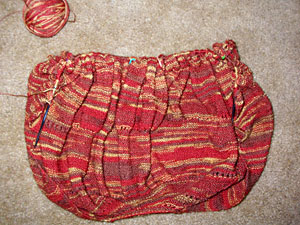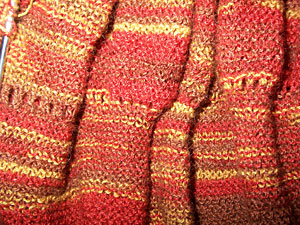Jim came up with a great solution to a minor knitting irritation: what to do with all that yarn when you have to frog a knitting project. It happens to all of us, so it seems. And because I am a “new” knitter, it happens to me more than I’d like it too.
I’m working on my first pair of socks, toe up in stockinette stitch, following the instructions in Janet Rehfeldt’s booklet, “Toe-Up Techniques for Hand Knit Socks.” First attempt: toe cast on was pretty lumpy. Rip it. Second attempt: just can’t get the hang of that toe. Rip it. After looking through my knitting books and searching the internet, I found a toe cast-on that looked good: Denise Powell’s toe up sock instructions. Oh, it is a good one. Toe is smooth inside and out and the cast on is pretty easy. I started my increases and kept going ’till the sock reached the base of my little toe, ‘cuase that’s what you are supposed to do. After increasing, I switched to working in the round and went to town – knitting ’till the sock reached my ankle bone. Then I tried it on. Too. Big. Way. There was no way around it. The sock had to be frogged.
Some people might be taken by surprise witnessing a person ripping out rows of their knitting. The first couple of times I had to frog a project, Jim seemed to feel for me. It’s not pretty to take hours of work and rip it apart in a matter of minutes, but when the sock is too big, the sock is too big and Jim has gotten used to my “do-overs.”
An ugly pile of yarn started to accumulate, and being the kind of person who’s always tuned in to how to solve a problem, Jim’s mind started to go to work. He must have been thinking about the tangled protein story he just read, or else the extension cord we keep in a bucket in the garage, or maybe it was a combination of the 2. In either case, what he suggested was a brilliant idea that made my post-sock frogging life so much better!
Jim grabbed a plastic cup and started to feed the yarn into it. The only special trick he used was to just stuff it in as I was feeding the yarn to him. Rip, stuff, rip, stuff and pretty soon all the frogged yarn was all in the cup.
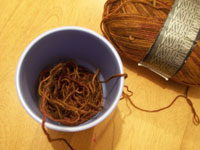
To be on the safe side, we taped the ball-end of the yarn to the side of the cup, to avoid the temptation to pull the wrong end, and all of the yarn, from the bottom of the cup.
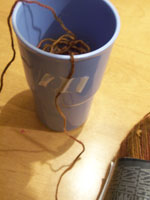
What was left was the working end of the yarn leading into the pile of yarn in the cup with the ball of yarn trailing behind waiting for me to catch up to it again.
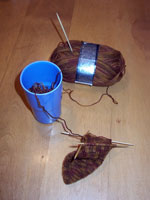
I started to knit again. Smooth cast on, fewer increases, then round and round all the while the yarn flowing from the plastic cup so smoothly it was like the yarn was floating in air. I’m not even kidding. For a moment I thought about pulling all of the yarn out of the ball and stuffing it into a cup.
That’s when the one thing that’s not-so-perfect about this process hit me: this is not a very portable solution. At least, it’s not as portable as a sock and a ball of yarn (sans the cup). So until I caught up to the ball yarn again I was pretty stationary with the entire project but did catch up soon enough and tonight I was Knitting In Public at our step-daughter’s orchestra concert! Woo!
So there you have it. If you have to frog a project instead of winding all that yarn around the ball (I find this to be an annoying way to work with a center-pull ball of yarn) just stuff that yarn into a cup. It’s a frogging dream come true! 🙂
(obligatory sock photos to come – once they are done!)

